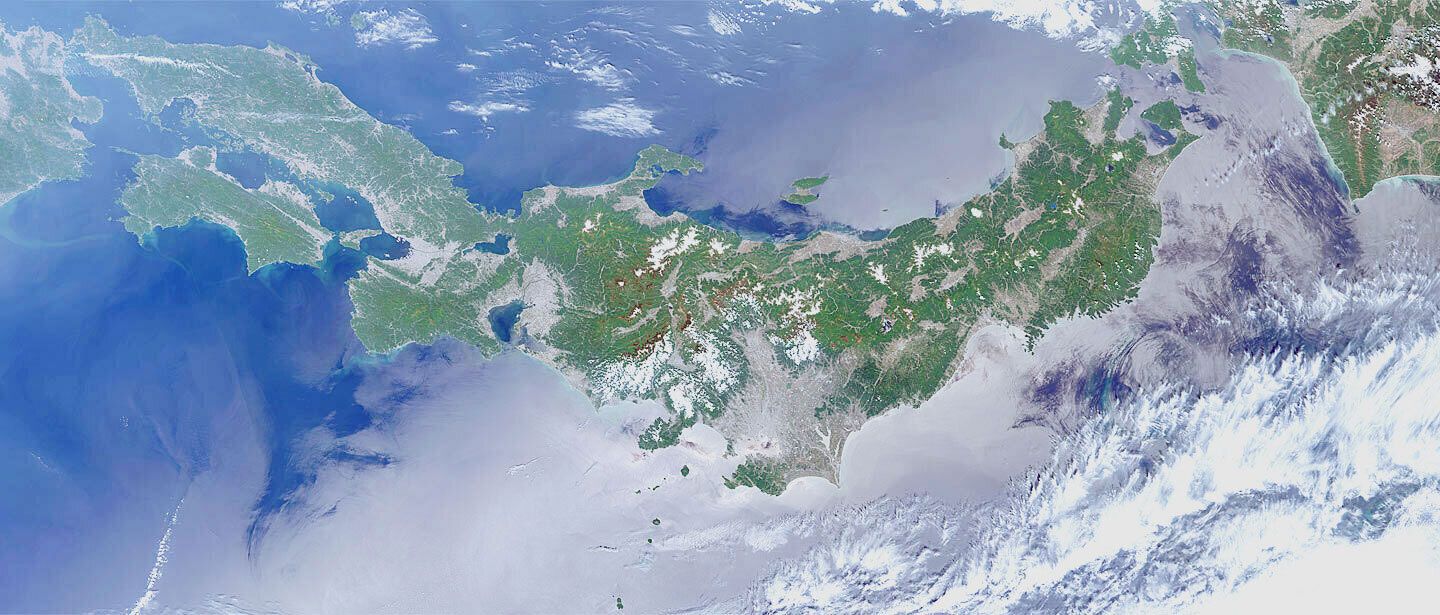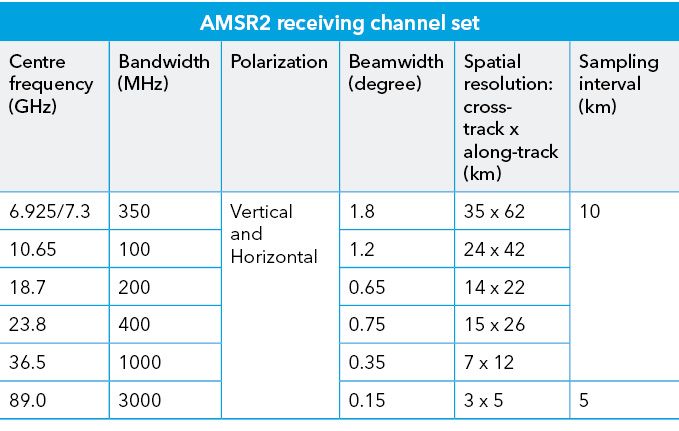
Sea surface temperature measurements using passive microwave sensors


Yasunori Iwana, Staff, Spectrum Management Office, and Misako Kachi,
Manager for GCOM‑W and AMSR3 Research, Earth Observation Research Center,
Japan Aerospace Exploration Agency (JAXA)
The ocean covers more than 70 per cent of the Earth’s surface and plays an important role in supplying water vapor to the atmosphere.
Satellites, given their global observation capabilities, are useful for observing the ocean, which includes measuring sea surface temperature (SST).
This key parameter for air‑sea interactions is widely used in weather and climate prediction, coastal disaster prevention, fisheries management, and ecosystem conservation.
Weekly SST maps are made with either traditional infrared (IR) or microwave imagers. The latter, which can observe day and night in all weather conditions, have become critical in the production of “daily” SST maps. To date, however, only a few types of microwave imagers are designed for sea surface temperature observation.
Opportunities for measuring with passive sensors
The Advanced Microwave Scanning Radiometer (AMSR) series developed by the Japan Aerospace Exploration Agency (JAXA) uses passive sensors to measure weak microwaves. These microwaves are radiated at varying frequencies from water particles in different states on land, on the sea surface, and in the atmosphere.
AMSR systems can observe various water-related parameters, including sea surface temperature, supporting such practical applications as numerical weather prediction, reports on sea conditions for fishing crews, and safe ship navigation, as well as water-cycle variations and climate change indicators.
First- and second-generation advanced microwave scanning radiometers
The first examples, AMSR‑E and AMSR, were installed, respectively, on the Aqua satellite launched by the US National Aeronautics and Space Administration (NASA) in May 2002 and on the Advanced Earth Observation Satellite‑II (ADEOS‑II) launched later the same year by the National Space Development Agency of Japan (NASDA).
The second-generation AMSR2, launched in May 2012, remains in operation with Japan’s Global Change Observation Mission — Water (GCOM‑W).
With an antenna rotating every 1.5 seconds, AMSR2 obtains data across a 1450‑kilometre (nominal) and 1620‑kilometre (effective) swath. A conical scanning mechanism enables it to acquire new sets of daytime and night-time data, with over 99 per cent coverage of the Earth, every two days.
Advanced satellite imaging technologies represent a huge asset for weather forecasting and climate monitoring. Breakthroughs achieved with the first two generations of the AMSR series were possible because of close international coordination efficient radio spectrum management.
Updates initiated by the ITU Radiocommunication Sector (ITU–R — one of three Sectors of the International Telecommunication Union) prior to 2012 ensured that the Radio Regulations treaty maintained by ITU would support rapidly evolving satellite services to meet the world’s changing needs.
Increasing sensitivity unaffected by the atmosphere
Compared to other passive microwave sensors, the AMSR series features a uniquely large antenna, about 2 metres in diameter, and can host channels in the 6–10 gigahertz (GHz) frequency. Since spatial resolution increases as centre frequency decreases, a large antenna is needed to obtain the best spatial resolution in 6–10 GHz channels (see table).

Those 6–10 GHz frequency bands constitute an “atmospheric window” in which microwaves emitted from the sea or land surface can penetrate thick clouds. Channels in those bands are less affected by atmospheric conditions, enabling sensitivity to subtle variations in surface temperatures at sea and even sub‑soil moisture on land.
The 6–7 GHz channels offer good SST sensitivity in almost all temperature ranges, while sensitivity in the 10 GHz band becomes degraded at temperatures below about 12 degrees Celsius.
As shown in the table, the 6.925 GHz, 7.3 GHz and 10.65 GHz channels in AMSR2’s multichannel receiver of are mainly used for SST and soil moisture-content measurements.
Higher frequency channels are also commonly available in older passive microwave sensors, such as the US Department of Defence’s Special Sensor Microwave/Imager (SSM/I), used to retrieve water vapor, rainfall, snow depth, sea-surface wind speed, and sea ice concentration.
The 7.3 GHz channel is dedicated to the mitigation of radio-frequency interference in the C‑band.
Next-generation microwave scanning
JAXA’s next-generation AMSR instrument, the Advanced Microwave Scanning Radiometer 3 (AMSR3), is intended for launch as a hosted payload on Japan’s forthcoming Global Observing Satellite for Greenhouse‑gases and Water-cycle (GOSAT‑GW) mission in the Japanese fiscal year of 2024 (April 2024–March 2025).
AMSR3 — as a deliberate upgrade from AMSR2 — will include several new channels, contributing to the retrieval of solid precipitation data, water vapor analysis for numerical weather predictions, and robust SST retrievals in higher resolution.
Download your copy of the ITU News Magazine: Science services.
Header image credit: SFCG
